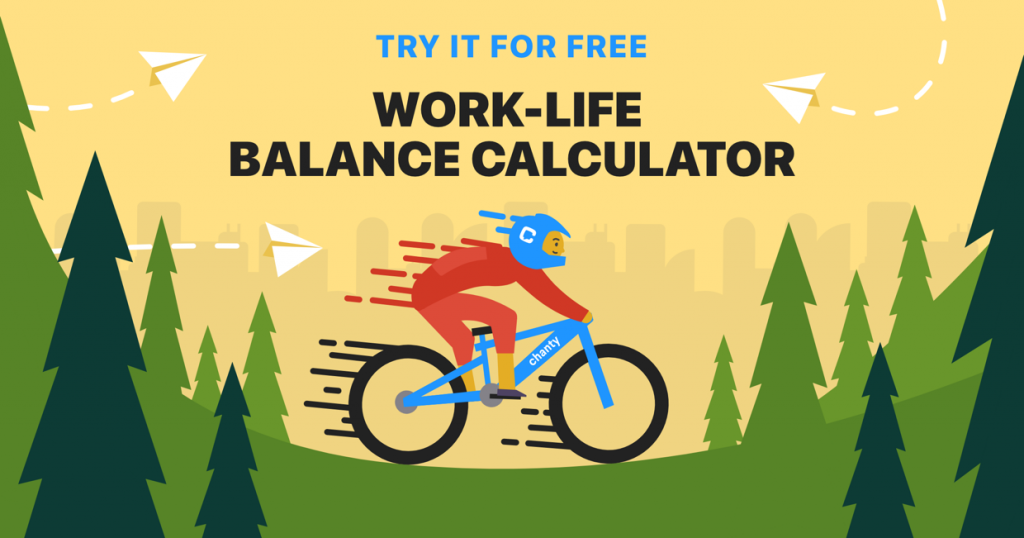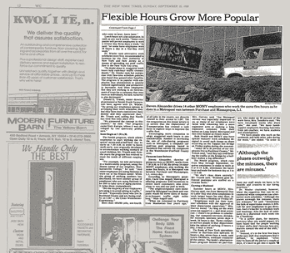Sitting in the office from 9 to 5 made me sick.
In the mornings, I worked quite efficiently, but after 2 p.m., it was all downhill. My attention would start to scatter. I would open my Facebook newsfeed and news websites, feeling guilty about not doing my best at work. At 4 p.m., my brain would officially become dead, so I would stare at the monitor, counting down the minutes until the workday ended. Is it something you can also relate to?
We discussed the issue with my boss and agreed to give work from home flexible hours a try. There is no fixed time—there is no need to sit in the office. Well, as long as all the deadlines are met and the objectives are achieved, of course.

How did the idea of flexible staffing make me feel? Well, I’m happy, for sure, but also puzzled. I’ve never worked unstructured hours in my life; my schedule has always been strict. I always viewed my superiors as Zen masters with sticks, keen to micromanage my performance. But here comes a totally different story.
Let me give you a short explanation. I’m a part of the Chanty team that is developing a simple team chat with unlimited message history and a task manager that is a breeze to use. We are striving to make a great collaboration app that suits your business needs. Join our community!
Here’s a photo of our team taken in July 2018. I (Alex) am in the middle of this picture. The lovely girls are our marketing team. The other two guys are our CEO Nick and front-end developer Max. I’m pleased to meet you!

Chanty team
I work as a copywriter and usually do reviews of team chat apps and business trends. So when I actually switched to a work from home flexible hours, I thought, why not share my experience on Chanty blog?
So here I am, wrapping up my first week of following the open-leave schedule. The diary is supplemented by a brief review of how flexible staffing arrangements are in the business world. I hope you’ll find it useful. Have a read!
The secret diary of a writer (who started working flexible working hours):
Day 1.
It’s morning, and I am thrilled! There is no need to get up early to get to work at 10 a.m. I sleep late and wake up an hour later than usual; it’s great to have a chance to improve my sleep. How about a 1-hour yoga practice? (I generally do 30 minutes.) My relatives ask me to do some chores. Clean the dishes? Screw in a bulb? Sure! Will you walk your 8-year-old nephew to school? His parents are always so busy. No problem! When I’m done, I glance at my watch. No way… It’s 2 p.m. already! It’s high time to get down to work… Writing at home feels unusual, though I’m spending the day alone. But at 7 p.m. I have a date with my partner, and I wouldn’t want to miss it. So I actually underwrote about four hours today. I’ll have to catch up with tasks tomorrow.
Quite a flexible start, right?
Day 2.
Mindful of yesterday’s home routine, I decided to work from the office today. But I allowed myself to arrive an hour later than usual. At 3 p.m., I feel tired. I’m trying to stand up and go home and have some rest, but I can’t do it. I feel awkward and uneasy and am not sure why yet. Not only that, but I’m looking around; everybody’s working hard without being aware of my flexible arrangements. “Goodbye” in the big open-space office would sound like a bolt from the blue. So I’m keeping a low profile and will tell my colleague in the nearest cubicle that I have to leave. “OK,” she just says. I go home and later work a bit more, but I guess not enough to catch up on tasks.
Day 3.
I’m staying at home today. I’m dead set to start working at 9 a.m. There are no urgent functions! No family chores, please. A nephew walks to school alone. He’s a grown man, for crying out loud! I’ve been working vigorously for the first few hours. But then I start wondering about vacations and browsing tourist offers. I keep telling myself, “Alex, pull your finger out!” and “Come on, man, get a move on!” By taking small steps, I manage to take myself in hand and work really hard. I stop at 10 p.m. only. I’ve done quite a lot, but it’s been a hard day, for sure. I’ve started using the screen time calculator to monitor the amount of time I spend at the computer.
Day 4.
Feeling tired from yesterday’s writing marathon, I’m staying to work at home. However, there is a bummer. As I’m out of the office, I can’t keep up with the usual workflow. So, the article topic I really wanted to write about has been assigned to another writer (they agreed on it while chatting in the office). Cripes! Moreover, the whole office is having a pizza party today. And I had some oatmeal for breakfast and nothing else yet. Argh! My colleagues also decorated a Christmas tree today. I kind of miss the office fun and mingling with guys.

Chanty Christmas tree
Day 5.
I go to the office, but in the afternoon I work from home. Having met this week’s deadlines, I’ve started some new tasks. I feel a bit baffled—the groove of a nine-to-five job is destroyed. But overall, the last day of the flexible week is quiet and easy. Looking forward to the weekend.
After week 1.
Basically, I feel better than usual. But did my productivity improve? To be frank, it’s been nearly the same this week. But I might need to work on my concentration and develop some time management skills. I might also download a great time-tracking app—just for myself.
My experience with work from home flexible hours is summarized in the table below:
Flexible staffing: how they might work for you? | |
Challenges | Advantages |
|
|
That rounds up my experience for now. But there’s certainly more to come, so stay tuned!
Now, here’s a brief review of flexible work time regulations as a worldwide practice.
Working time regulations in 2018: global experience
“Flexible Work Hours Grow More Popular.” I meant to start with this trivial sentence. But then I found the NYT of 1988 article with the exactly same title. So it’s been going on for at least a quarter-century!

September 25, 1988, Page 12. The New York Times Archives.
If you are interested in how “flexible staffing” policies have evolved since the 1990s, check out this US labor study by the National Bureau of Economic Research. It turns out that nearly all new jobs that appeared in the last decade (from 2005 to 2015, to be specific) had flexible staffing arrangements. So how do I put it right? Are “working time regulations” popular now? I guess the phrase “going through the roof” describes this trend best. Have a look at these titles in major business outlets.



Forbes and NYT article titles
I would even say that after exploring this topic, I’m surprised nine-to-five jobs are still quite widespread.
Do top businesses offer them? Absolutely. Google has been one of the first companies to understand the need for employees to have a flexible schedule. Apple is more than fine with flexible work arrangements. Last year, the company hired 100 work-from-home professionals with full benefits. At Microsoft, many employees choose when to start their day. Toyota, one of the richest companies in the world, was expanding the number of workers eligible for flexible staffing in 2017.
The advantages of work from home flexible hours for businesses are obvious. They are a powerful lure in recruiting and motivating top talent, as flex time ranks high on the list of benefits employees want. Moreover, the open-leave schedule contributes to a greener workplace, as companies save on electricity, water, office rent, etc.
But there are also some downsides. For example, it is believed that company culture is stronger when people work nine-to-five. Also, flexible hours can make client handovers complicated. However, in many cases, management’s opposition to soft time regulations is motivated by habit. An example would be the case described in Forbes’ article about a team leader who didn’t allow his employee to switch to flexible staffing despite her showing great work results.
Actually, there are so many working time regulations that it’s hard to believe there isn’t an option management and employees can agree on. Staggered hours, reduced schedules, remote work options, and even mini-sabbaticals are all part of the present and future of work.
If you are a big boss, here is a compelling case for implementing softer work time regulations in your organization. Work from home flexible hours dramatically affect happiness, as studies suggest, while there’s no doubt contented workers perform better and are more loyal to their employers.
Conclusion
I’ve just started working flexible. The change made me feel better, but I was perplexed by the difficulties it brought up. But I guess it would be too early to draw any far-reaching conclusions based on my one-week exploration. However, global experience indicates that flexible work time regulations are becoming increasingly popular. They pay off for both companies and employees. It’s all about finding a suitable open-leave schedule option that can work for both sides.
Here’s one last thing: if you switched to flexible hours and work remotely a lot, be sure to use a proper communication tool to stay in touch with your team. Collaboration apps are literally digital workspaces that help connect and bring employees together, no matter where they work. Talk to your team using public, private, and direct messaging. Have audio or video calls with your colleagues, share files, and use your favorite integrations to organize your workflow. We’ve designed a smart, intuitive, and easy-to-use Chanty team chat to assist you in being more productive. Using it is like having three extra hours in a day! Give it a try.
Stay on top of things, following the workflow in public and private channels and via direct messages. With a push of a button, you can have an audio call or video chat with your colleague.










Add comment